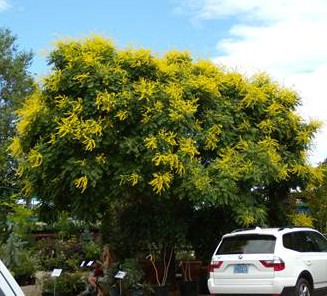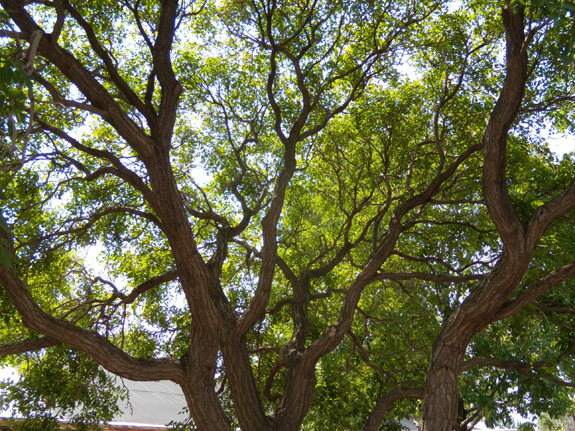Scientific name: Koelreuteria paniculata
Plant Family: Sapindaceae
Common names: Golden Rain Tree, Pride of India, China Tree, Varnish Tree
Article by Susan Bruneni
When Santa Fe Botanical Garden completes the new Botanical Garden on Museum Hill, one of the trees included will be the Golden Rain Tree. This showy plant is a non-native recommended by New Mexico State University and the City of Las Vegas for tolerance to drought, temperature extremes, and deer. Its yellow flowers and paper-lantern-like pods are now commonly found in Albuquerque and Santa Fe.
The Golden Rain Tree was first grown in the United States in 1809. Thomas Jefferson received seeds from his Parisian friend, Madame de Tesse. He wrote to her in 1811 that a seed had germinated. The seedling was eventually planted in the garden at Monticello, where the Golden Rain Tree is now naturalized. Jefferson’s reference was the first mention of Koelreuteria paniculata in the New World.
The concept of Jefferson’s Monticello Garden will be further explored in Santa Fe Botanical Garden’s March 14th lecture, Thomas Jefferson’s Revolutionary Garden at Monticello: Its Roots in Post-Revolutionary England and Pre-Revolutionary France.
Some accounts claim the Golden Rain Tree was introduced in England by 1560, but most accounts say it was the French Jesuit Pierre d’Incarville, one of the few privileged explorers allowed into China during the mid-18th Century, who collected the seeds in Peking and sent them back to Europe with a Russian caravan. They were growing in the Royal Garden by 1763.
Plant species were carefully selected for the living collection of the new garden on Museum Hill. Mr. Tracy Neal, a local horticultural consultant and key member of the team selecting plants for the garden, listed several reasons why this plant was included:
- It’s a tough, low-maintenance, fairly drought-tolerant exotic that grows surprisingly well here in our humus-poor alkaline soil.
- It has a showy bloom in the summer, when almost no other tree is blooming.
- It has nice compound, almost-tropical looking foliage.
- The seed pods are another ornamental feature, and remind some people of “Chinese lanterns”.
- The structure is informal, and it develops nice character with age. The growth rate is moderate.
Tracy further notes, “It will be small when it’s planted (only about 7′ tall), but as it grows it will be pruned up so that people can look through the cool trunk structure to the garden. These are trees that are nice to see close up, so even when it’s small it will be an attractive accent.”
The Golden Rain Tree is a hardy, medium-sized, deciduous tree with large clusters (8”-18”) of bright yellow flowers that cover the tree for several weeks in early or mid summer, followed by papery lantern-like pods. The tree grows 25-35 feet high with a 25-40-foot roundish head.
Leaves are alternate, feather-compound (sometimes the larger, middle leaflets are themselves compound), up to 18 inches long. Each leaf has 7–17 leaflets that are irregularly lobed and deeply toothed.
The scientific name “Koelrueteria” was chosen to honor Joseph Koelreuter an 18th Century German botanist credited with developing the process of hybridizing.




